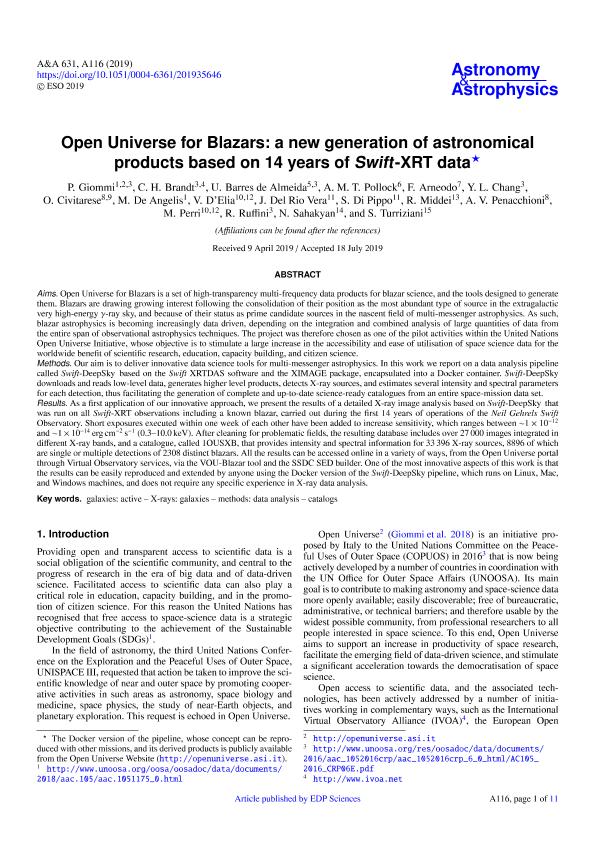Artículo
Open Universe for Blazars: A new generation of astronomical products based on 14 years of Swift -XRT data
Giommi, Paolo; Brandt, C. H.; Barres de Almeida, U.; Pollock, A. M. T.; Arneodo, F.; Chang, Y. L.; Civitarese, Enrique Osvaldo ; de Angelis, Maria Cruz; D'Elia, V.; Del Rio Vera, J.; Di Pippo, S.; Middei, Riccardo; Penacchioni, Ana Virginia
; de Angelis, Maria Cruz; D'Elia, V.; Del Rio Vera, J.; Di Pippo, S.; Middei, Riccardo; Penacchioni, Ana Virginia ; Perri, M.; Ruffini, Remo; Sahakyan, Narek; Turriziani, Sara
; Perri, M.; Ruffini, Remo; Sahakyan, Narek; Turriziani, Sara
 ; de Angelis, Maria Cruz; D'Elia, V.; Del Rio Vera, J.; Di Pippo, S.; Middei, Riccardo; Penacchioni, Ana Virginia
; de Angelis, Maria Cruz; D'Elia, V.; Del Rio Vera, J.; Di Pippo, S.; Middei, Riccardo; Penacchioni, Ana Virginia ; Perri, M.; Ruffini, Remo; Sahakyan, Narek; Turriziani, Sara
; Perri, M.; Ruffini, Remo; Sahakyan, Narek; Turriziani, Sara
Fecha de publicación:
11/2019
Editorial:
EDP Sciences
Revista:
Astronomy and Astrophysics
ISSN:
0004-6361
Idioma:
Inglés
Tipo de recurso:
Artículo publicado
Clasificación temática:
Resumen
Aims. Open Universe for Blazars is a set of high-transparency multi-frequency data products for blazar science, and the tools designed to generate them. Blazars are drawing growing interest following the consolidation of their position as the most abundant type of source in the extragalactic very high-energy γ-ray sky, and because of their status as prime candidate sources in the nascent field of multi-messenger astrophysics. As such, blazar astrophysics is becoming increasingly data driven, depending on the integration and combined analysis of large quantities of data from the entire span of observational astrophysics techniques. The project was therefore chosen as one of the pilot activities within the United Nations Open Universe Initiative, whose objective is to stimulate a large increase in the accessibility and ease of utilisation of space science data for the worldwide benefit of scientific research, education, capacity building, and citizen science. Methods. Our aim is to deliver innovative data science tools for multi-messenger astrophysics. In this work we report on a data analysis pipeline called Swift-DeepSky based on the Swift XRTDAS software and the XIMAGE package, encapsulated into a Docker container. Swift-DeepSky downloads and reads low-level data, generates higher level products, detects X-ray sources, and estimates several intensity and spectral parameters for each detection, thus facilitating the generation of complete and up-to-date science-ready catalogues from an entire space-mission data set. Results. As a first application of our innovative approach, we present the results of a detailed X-ray image analysis based on Swift-DeepSky that was run on all Swift-XRT observations including a known blazar, carried out during the first 14 years of operations of the Neil Gehrels Swift Observatory. Short exposures executed within one week of each other have been added to increase sensitivity, which ranges between ∼1 × 10-12 and ∼1 × 10-14 erg cm-2 s-1 (0.3-10.0 keV). After cleaning for problematic fields, the resulting database includes over 27 000 images integrated in different X-ray bands, and a catalogue, called 1OUSXB, that provides intensity and spectral information for 33 396 X-ray sources, 8896 of which are single or multiple detections of 2308 distinct blazars. All the results can be accessed online in a variety of ways, from the Open Universe portal through Virtual Observatory services, via the VOU-Blazar tool and the SSDC SED builder. One of the most innovative aspects of this work is that the results can be easily reproduced and extended by anyone using the Docker version of the Swift-DeepSky pipeline, which runs on Linux, Mac, and Windows machines, and does not require any specific experience in X-ray data analysis.
Palabras clave:
ACTIVE
,
CATALOGS
,
DATA ANALYSIS
,
GALAXIES
,
GALAXIES
,
METHODS
,
X-RAYS
Archivos asociados
Licencia
Identificadores
Colecciones
Articulos(IFLP)
Articulos de INST.DE FISICA LA PLATA
Articulos de INST.DE FISICA LA PLATA
Citación
Giommi, Paolo; Brandt, C. H.; Barres de Almeida, U.; Pollock, A. M. T.; Arneodo, F.; et al.; Open Universe for Blazars: A new generation of astronomical products based on 14 years of Swift -XRT data; EDP Sciences; Astronomy and Astrophysics; 631; A116; 11-2019; 1-11
Compartir
Altmétricas



